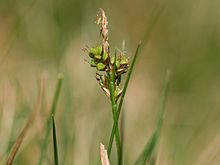Carex pilulifera
| Carex pilulifera | |
|---|---|

| |
| Scientific classification | |
| Kingdom: | Plantae |
| Clade: | Tracheophytes |
| Clade: | Angiosperms |
| Clade: | Monocots |
| Clade: | Commelinids |
| Order: | Poales |
| Family: | Cyperaceae |
| Genus: | Carex |
| Subgenus: | Carex subg. Carex |
| Section: | Carex sect. Acrocystis |
| Species: | C. pilulifera
|
| Binomial name | |
| Carex pilulifera | |
| Synonyms [1] | |
|
Carex oederi Retz. | |
Carex pilulifera, the pill sedge,[2] is a European species of sedge found in acid heaths, woods and grassland from Macaronesia to Scandinavia. It grows up to 30 cm (12 in) tall, with 2–4 female spikes and 1 male spike in an inflorescence. These stalks bend as the seeds ripen, and the seeds are collected and dispersed by ants of the species Myrmica ruginodis.
Varieties:
- Carex oederi var. oederi (synonym: Carex scandinavica E.W.Davies)[3]
Description[edit]

The culms of Carex pilulifera grow to a length of 8–30 centimetres (3–12 in), and are often noticeably curved.[4] The leaves are 5–20 cm (2–8 in) long and 1.5–2.0 millimetres (0.06–0.08 in) wide, and are fairly flat.[4] The rhizomes of C. pilulifera are very short, giving the plant a caespitose (densely tufted) appearance.[4] The tussock grows outwards through the production of annual side-shoots.[5]
The inflorescence comprises a single, terminal, male (staminate) spike, and 2–4 lateral female (pistillate) spikes.[4] The spikes are clustered together, and the whole inflorescence is 1–4 cm (0.4–1.6 in) long.[4] The female spikes are 4–8 mm (0.16–0.31 in) long, ovoid or approaching spherical,[4] and contains 5–15 flowers.[5] The female spikes are attached directly to the stem, and each is subtended by a bract which does not form a sheath.[4] The male spike is 8–15 mm (0.3–0.6 in) long and much narrower.[4]
Distribution and ecology[edit]
Carex pilulifera has a wide distribution in Europe, extending from Macaronesia and the Balkan Peninsula to Scandinavia.[1] It grows on acidic substrates including heathland, grassland and woodland.[5] It typically inhabits soils with a pH of 4.5–6.0.[4]
As the seeds of C. pilulifera ripen, the culms bend, and can eventually touch the ground.[5] The seeds are then dispersed by ants, particularly Myrmica ruginodis,[5] in a process known as myrmecochory, and are eaten by other insects, such as the ground beetle Harpalus fuliginosus.[5]
Taxonomic history[edit]
Carex pilulifera was described by Carl Linnaeus in his 1753 work Species Plantarum, which marks the starting point of botanical nomenclature.[1] The specific epithet pilulifera means "bearing small globular structures", in reference to the female spikes.[6]
References[edit]
- ^ a b c A. O. Chater (2010). "Carex". In T. G. Tutin; V. H. Heywood; N. A. Burges; D. A. Webb; I. B. K. Richardson (eds.). Alismataceae to Orchidaceae. Flora Europaea. Vol. 5. Cambridge University Press. pp. 290–323. ISBN 978-0-521-15370-6.
- ^ BSBI List 2007 (xls). Botanical Society of Britain and Ireland. Archived from the original (xls) on 2015-06-26. Retrieved 2014-10-17.
- ^ "Carex scandinavica E.W.Davies | Plants of the World Online | Kew Science". Plants of the World Online. Retrieved 15 February 2021.
- ^ a b c d e f g h i A. C. Jermy; D. A. Simpson; M. J. Y. Foley; M. S. Porter (2007). "Carex pilulifera L.". Sedges of the British Isles. BSBI Handbook No. 1 (3rd ed.). Botanical Society of the British Isles. pp. 431–433. ISBN 978-0-901158-35-2.
- ^ a b c d e f Gösta Kjellsson (1985). "Seed fate in a population of Carex pilulifera L. I. Seed dispersal and ant-seed mutualism". Oecologia. 67 (3): 416–423. doi:10.1007/BF00384949. JSTOR 4217752. PMID 28311577. S2CID 19960204.
- ^ "Pillerstarr, Carex pilulifera L." Den virtuella floran (in Swedish). Naturhistoriska riksmuseet. July 28, 2010. Retrieved July 25, 2011.
External links[edit]
 Media related to Carex pilulifera at Wikimedia Commons
Media related to Carex pilulifera at Wikimedia Commons
